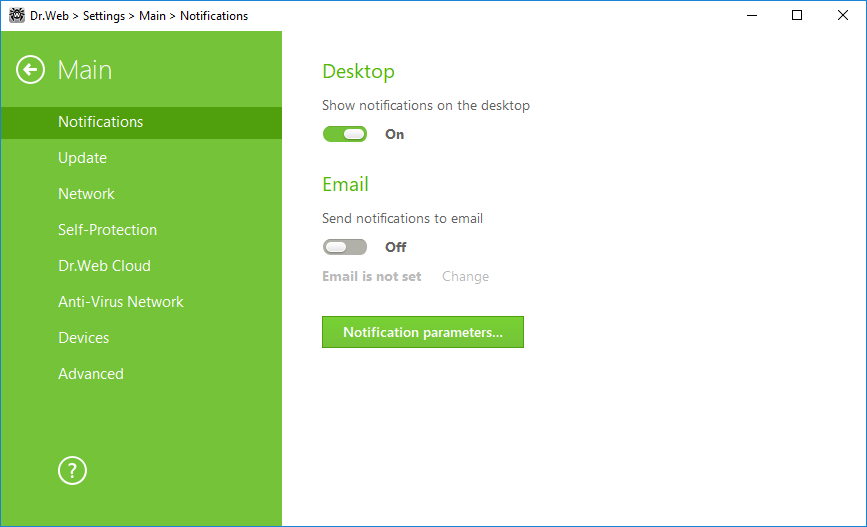In this section you can configure parameters of Dr.Web Anti-virus for Windows Servers performance notifications.
Pop-up notifications
Enable the appropriate option to get pop-up notifications above Dr.Web icon ![]() in the Windows notification area.
in the Windows notification area.

Figure 16. Notifications settings
Email notifications
To receive email notifications about events, do the following:
1.Enable the Send notifications to email option.
2.Specify the email address that you want to use for receiving notifications in the appeared window. You will need to confirm this email address at step 7.
3.Click Next.
4.Specify the data of the account that will be used to send notifications.
•Select the mail server from the list and enter your account login and password.
•If the required mail server is not on the list, select Set manually. In the open window, fill in the fields. ![]() Details
Details
Option |
Description |
|---|---|
SMTP server |
Specify the outgoing (SMTP) server for Dr.Web to use when sending email notifications. |
Port |
Enter the port for Dr.Web to use when connecting to the mail server. |
Login |
Enter the login for Dr.Web to use when connecting to the mail server. |
Password |
Enter the password for the login to be used when connecting to the mail server. |
Use SSL/TLS |
Select this check box to use SSL/TLS encryption when sending messages. |
NTLM authentication |
Select this check box to use NTLM authentication when connecting to the mail server. |
5.Click Send a test message if you want to make sure that all the details are specified correctly. The message is forwarded to the email address that will be used to send notifications (specified at step 4).
6.Click Next.
7.Enter the conformation code that was sent to the email address specified at step 2. If you do not receive the message within 10 minutes, click Send the code again. If you do not enter the code, notifications to this email address will not be sent.
8.To change the email address and other parameters, click Edit and repeat all the actions starting from step 2.
9.Click Notifications parameters and set the required notification types. By default, all types of email notifications are disabled.
Notifications parameters
1.Click Notifications parameters.
2.Select notifications that you want to receive. To display pop-up notifications, enable check boxes in the Desktop column. To receive mail notifications, enable check boxes in the Mail column. If you do not want to receive any notifications, disable all check boxes.
Notification type |
Description |
|---|---|
Threat is detected |
Notifications on threats detected by SpIDer Guard. By default, these notifications are enabled. |
Critical notifications |
Notifications on the following critical issues: •Failures to make a protected copy. By default, these notifications are enabled. |
Major notifications |
Important notifications on the following issues: •Device is blocked. •Attempt to change system date and time is blocked. •Attempt to access a protected object is blocked by Preventive Protection. •New version is available. •Virus databases are out of date. By default, these notifications are enabled. |
Minor notifications |
Minor notifications on the following issues: •Successful update. •Update failures. By default, these notifications are disabled. |
License |
Notifications on the following issues: •License expires. •Valid license is not found. •The current license is blocked. |
3.If necessary, configure additional parameters:
Option |
Description |
|---|---|
Do not show notifications in full-screen mode |
Hide notifications when an application is running in full-screen mode on your computer (e.g., a game or a movie). Clear this check box to display notifications regardless of the mode. |
4.If you selected one or more email notifications, configure sending emails from your computer.
Notifications on the following issues are not included in any of the specified groups and are always displayed to the user: •Priority updates installed and restart is required. •To finish neutralizing threats, restart the computer. •To enable or disable the hypervisor, restart the computer. •Request for allowing a process to modify an object. •Successful connection to a remote computer in the Anti-virus Network. |